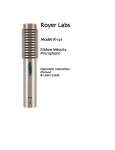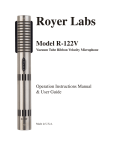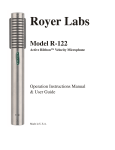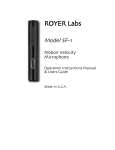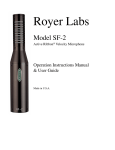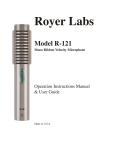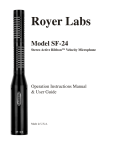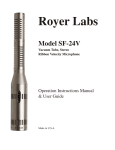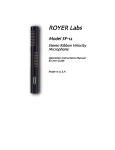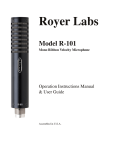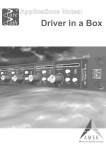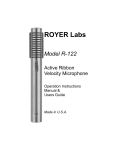Download SF-2 Manual NEW
Transcript
Royer Labs Model SF-2 Active Ribbon™ Velocity Microphone Operation Instructions Manual & User Guide Made in U.S.A. TABLE OF CONTENTS Model SF-2 Ribbon Microphone Introduction Active Ribbon™ Technology Description Applications Ribbons in the Digital World User’s Guide 3 3 4 4 5 5 Using the SF-2 Active Ribbon™ Microphone 5 Operation Using the RSM-24 Shock Mount Accessory 6 7 Description 7 Features 7 Usage 7 Properly Inserting the Microphone into the Shock Mount 7 Amplification Considerations Equalization and Ribbon Microphones Hum, Noise & Mic Orientation The Sweet Spot Finding and Working with the Sweet Spot Other Types of Microphones Proximity Effect and Working Distance The Sound That is “More Real than Real” Microphone Technique General Tips for Using Ribbon Microphones Recording Loud or Plosive Sounds Stereophonic Microphone Technique Classic Blumlein Technique Mid-Side Technique Care and Maintenance Care for the Optical Black Finish Features and Specifications SF-2 Features: 9 9 10 11 11 11 12 12 13 13 14 14 14 14 16 16 17 17 SF-2 Specifications: 17 Polar Pattern Frequency Response Warranty 18 18 19 Introduction Congratulations on your purchase of a Royer Labs model SF-2 active ribbon™ microphone. The SF-2 is a handcrafted precision instrument capable of delivering superior sound quality and overall high performance. This operator’s manual describes the SF-2, its function and method of use. It also describes the care and maintenance required to ensure proper operation and long service life. The users guide section of this manual offers practical information that is designed to maximize the performance capabilities of this microphone. Royer Labs products are manufactured to the highest industrial standards, using only the finest materials obtainable. Your model SF-2 went though extensive quality control checks before leaving the factory. Normal care, given to any quality instrument, is all that is required to assure years of trouble-free service. Please read this manual thoroughly in order to become familiar with all of the SF-2’s capabilities. It will assist you in making the most of the microphone’s superior acoustic properties. This owner’s manual is a handy reference guide and we suggest you refer to it whenever questions arise on the use and care of your SF-2 ribbon microphone. Active Ribbon™ Technology Royer Labs developed the world’s first commercially available phantom-powered and vacuum tube ribbon ribbon microphones. The heart of the SF-2 is its proprietary electronic system consisting of a specially designed toroidal transformer and electronic buffering stage. This system provides excellent frequency response, extremely low noise and distortion, and high SPL handling (130 dB) without the use of a pad. It gives the SF-2 an output level comparable to that of condenser microphones, and its buffer stage provides a low impedance output and presents an optimum load to the ribbon element. Unpowered ribbon microphones suffer substantially degraded frequency response and lowered gain when they are paired to a preamp with too low of an input impedance. With the SF-2’s active electronic system, the microphone’s frequency response and output are much less affected by variations in the input impedance of the following preamp. Sonically the SF-2 differs from the unpowered SF-1 in one subtle way: due to the extra iron in the SF-2’s much larger transformer, low-end frequencies sound slightly tighter and more focused. Key Points: • No longer is it necessary to mate a ribbon microphone to an ultra-high gain, low noise preamplifier for optimum performance. Any preamplifier of nominal gain will provide good results with the SF-2. • No longer is it necessary to carefully consider impedance matching characteristics when choosing a preamplifier. Microphone loading is a non-issue and consistent performance is assured, regardless of the preamplifier’s impedance characteristics. • No longer is it necessary to be concerned about damaging the ribbon element with phantom power. The active electronics need phantom power to operate - a first for ribbon microphones. • No longer is it necessary to worry about the effects of long cable runs degrading the performance of your ribbon microphone. The active electronics provide a robust low impedance signal that can handle long cable lengths with minimal loss of signal. Description The Royer Labs model SF-2 is an ultra compact bi-directional (figure-eight) velocity type ribbon microphone designed for professional applications. The figure-eight pick-up pattern allows the SF-2 to be addressed from either side with equal sensitivity. The in-phase signal is achieved when the microphone is addressed from the front, indicated by the “ROYER” logo. The SF-2 is reasonably tolerant to shock and vibration, and is unaffected by changes in temperature or humidity. However, ribbon microphones are sensitive to direct blasts of air and the SF-2 is no exception to this rule. Discretionary use of a windscreen or pop-filter, such as the WS58, PS-101 or equivalent, is highly recommended for situations such as close miking, especially with vocalists or certain types of percussion and wind instruments. It is important to note that although Royer ribbon microphones are known to be tough and durable they still must be treated with the respect offered to any fine instrument. While all Royer’s are built to last a lifetime, the thicker ribbon element in our R-series mics can take more abuse than the finer, somewhat more delicate ribbon element in your SF-2. The SF-2 can handle over 130 dB SPL, while the R-121 can handle levels greater than 135 dB SPL. Please be aware of this as you use your SF-2. When handled with care, it will be many years before you need to re-ribbon your microphone (ribbons can last indefinitely if not abused). Applications The Royer Labs model SF-2 is a versatile microphone and is ideally suited for many critical recording applications. Its smooth frequency response characteristics and ability to capture detail make it a fine choice for many instruments. Orchestral instruments are captured in a very natural sounding way, free from microphone induced “hype.” The SF-2 has exceptionally smooth high frequency characteristics. Phase-related distortion and irregular frequency peaks are conspicuously absent. Theater organs and electric guitar amplifiers sound big and fat, without unnatural coloration, when reproduced with the SF-2. These characteristics make the SF-2 ribbon microphone an ideal choice for strings, woodwinds, percussion and all acoustic instruments. Acoustic pianos can be captured accurately without the comb-filtering effects associated with condenser microphones. Ribbons in the Digital World Digital recordings benefit greatly from the properties inherent in ribbon microphones. Since A to D converters cannot distinguish between the sound source being recorded and the complex distortion components often associated with condenser microphones, they sometimes have difficulty tracking the signal, resulting in ringing and edgy-sounding tracks. With ribbon microphones, ringing is almost nonexistent due to the ribbon’s lack of distortion artifacts and high-frequency peaks. A to D converters have less difficulty tracking the ribbon-generated signal, resulting in very smooth digital recordings free of microphone-related edginess. User’s Guide Using the SF-2 Active Ribbon™ Microphone The head amplification system in the SF-2 was designed to operate with standard 48-volt simplex phantom power sources only. The microphone will not work at all if phantom power is not provided to the microphone! This aspect of an active ribbon microphone is in sharp contrast to conventional ribbon microphones, in which phantom power usually spells danger or destruction to the ribbon element. Royer’s active series ribbon microphones require phantom power to operate. To ensure long service life of your SF-2 active ribbon™ microphone, care should be taken when connecting the microphone to a phantom power source. We have prepared a few tips to ensure that your SF-2 will perform perfectly for many years. We offer the following information as a general set of good habits that apply to both active ribbon mics and solid-state condenser microphones. 1. Although it is usually safe to “hot plug” most phantom-powered microphones to a preamplifier or console with the phantom activated, we suggest that if it is possible to deactivate the phantom power prior to plugging in the microphone, do so. This minimizes any chance of random voltage surges entering the microphone. More importantly, it reduces the possibility of loud pops being transmitted to your monitor speakers should the volume control be raised. Serious damage to your speakers could result from this oversight. 2. Be certain that the input channel fader or volume control is set to minimum before plugging in any microphone. Preamplifier gain trim should be set to minimum. Plug the microphone in and activate the phantom power switch. The microphone’s electronics will stabilize in a few seconds. 3. When the microphone becomes operational, bring the channel fader to 0-dB (unity) and use the gain-trim to set the desired level. This technique maximizes the signal-to-noise performance of the preamplifier or console input channel. 4. When disconnecting the microphone, bring the channel faders down and unplug the microphone cable ends. It is also advisable to turn off the phantom power before unplugging the microphone whenever possible. 5. If the studio has the microphone lines brought to a patch bay (tie lines), never crosspatch a microphone line when phantom power is applied or the monitor volume is raised. This could cause damage to your microphone, preamplifier or monitor speakers. Operation The SF-2 ribbon microphone is a versatile device capable of accurate sound reproduction. There are a few important facts about ribbon microphones that are key in understanding how to use them intelligently. 1. The SF-2 is a side address, figure-8 (bi-directional) microphone and the rejection in the “dead” areas is very strong. The dead areas are the sides, top and bottom of the microphone. Engineers use the dead areas of figure-8 microphones to isolate instruments by positioning the mics in such a way that the dead areas face, and cancel, offending sound sources. 2. In the horizontal plane, ribbon microphones do not discriminate against the “highs” off axis; nor do they boost them on axis. Therefore, several instruments or vocalists can be placed in front of the microphone without favoring the performer in the center of the group. Several performers can be grouped at both the front and back of the microphone, with one proviso: Since the outputs are out of phase at the front and back of the microphone, cancellation can result if two tenors are placed at opposite sides at equal distances and they are singing in unison, so listen to the feed before committing to it. 3. When using a ribbon microphone with loud signal sources, placing the microphone slightly off axis to the signal source is all that is required for efficient operation. 4. The Royer model SF-2 is a phantom-powered microphone and must be connected to a preamplifier or console cable of delivering 48-volts at a minimum of 4-milliamperes. Faulty or improperly wired cables could cause your SF-2 to become inoperative. Since the active electronics offer electrical isolation to the ribbon, a mis-wired cable should not cause damage to the ribbon. 5. Never attempt to “test” the SF-2 or any ribbon microphone with an ohmmeter. A blown ribbon could result. 6. Always provide adequate protection by using a windscreen or mic sock with your SF-2, or any ribbon microphone. 7. If the microphone is to remain set up on a stand when not in use, place the provided mic sock over it until it is to be used. Do not carry the microphone around without placing a mic sock over it. Failure to follow this commonsense practice may yield a stretched ribbon and compromised performance! Using the RSM-24 Shock Mount Accessory Description Your SF-2 is supplied with a Royer RSM-24 suspension type shock mount designed specifically for this microphone. The RSM-24’s specially formulated polymer mounts provide maximum isolation from shock and vibration while holding the SF-2 securely in place, allowing the microphone to be safely positioned at any angle. The RSM-24’s Delrin support tubes are relieved on the inside to minimize contact with the microphone. Teflon strips are bonded to the inside of the Delrin tubes and serve as a means to slide the microphone in and out of the shock. It is normal for the Teflon strips to develop wear marks with repeated use. Features The shock mount easily accommodates standard 5/8"- 27 male microphone stand threads. The support frame is machined from solid T-6 hard aluminum, then black anodized for long life and a clean unobtrusive appearance. The clutch mechanism provides easy positioning of the shock with minimal pressure. There is also a relief button that enables the clutch handle to be repositioned out of the way. The RSM-24 shock mount was originally designed for our SF-24 stereo ribbon microphone, so it has two orientation slots: one for on-axis recording (A-slot) and one positioned at 45° left of center (B-slot) for easy X-Y and M-S positioning. When recording with the SF-2 use the A-slot. Usage It is important to use the RSM-24 shock mount correctly. Making sure that the microphone is inserted properly into the shock mount will minimize any chance of the mic coming loose and will ensure proper orientation of the transducer element. It is also important to make certain that the mic is inserted and removed gently to avoid unnecessary shock to the ribbon. Properly Inserting the Microphone into the Shock Mount Examine the shock carefully. Observe that the upper Delrin support tube has one slot inside the tube that faces forward, the same direction as the logo, and one slot that faces 45º to the left of center. The forward (A) slot is used to orient the center, on-axis position of the microphone. The microphone Figure 1 is inserted in such a manner that the "ROYER" logo on the microphone nestles comfortably in this slot (Figure 1). Hold the mic by placing the transducer (ribbon element) end in the palm of one hand. While holding the shock mount in the other hand, gently insert the microphone's base into the upper tube first. Be sure that the logo on the microphone aligns itself with the slot in the upper support tube as you feed the mic through (Figure 2). Continue to feed the microphone through the upper tube and into the lower tube, where it will stop when it reaches the lip at the bottom of the lower tube. Do not force or jerk the microphone into position! Removing the Microphone from the Shock Removal is simply the reverse process. Firmly grip the microphone with one hand and gently slide it out of the shock (Figure 3). It may help to gently push from the bottom of the microphone while removing it from the lower tube. Again, be sure not to force or jerk the microphone. Ribbon elements are sensitive to abrupt shocks and blasts of air, so be gentle (Figure 3). Figure 2 Note: If, after a time, body oils or other contaminants make it difficult to insert or remove the microphone from the shock mount, a small amount of talc can be used to "lubricate" the microphone housing. Use talc very sparingly and do not let any of it get into the ribbon transducer, as it can compromise the ribbon’s performance. Connecting the SF-2 Although the active electronics are robust and the ribbon element is electronically isolated from the outside world, it is wise to make all your electrical connections prior to activating phantom power. Avoid cross-patching any microphone tie lines with phantom power activated, as this is equivalent to having a momentarily "defective" cable as the patching cords are inserted. This not only stresses the microphone's electronics but can harm a phantom power source and produce loud thumps in your speakers. Figure 3 Since the SF-2 is active, its low impedance output allows for long cable runs with minimal effect on the microphone’s performance. High-frequency response losses and noise pickup will be minimal even with cable runs up to several hundred feet. Amplification Considerations Most quality microphone preamplifiers with nominal to high gain characteristics and a built-in 48-volt phantom power source will achieve excellent results with your SF-2 active ribbon microphone. Unlike standard ribbon microphones, which depend on a proper impedance match to deliver optimal performance, the input impedance of your preamplifier will have minimal effect on the SF-2’s performance because the ribbon element is loaded perfectly via the microphone’s internal electronics. Careful consideration should be given to the quality of the microphone preamplifier. Studio grade preamplifiers usually sound much better than cheaper ones. Headroom, noise floor, transparency and coloration are all factors to consider in determining which preamplifier is suitable for your studio or live applications. Other features are usually secondary and fall into the category of conveniences or interface capabilities (such as digital or optical outputs). A good preamplifier should sound natural, with no sign of edginess or excessive noise. Vacuum tube preamplifiers sound warm, yet wonderfully airy and transparent. Do not expect a vacuum tube preamplifier to be as quiet as a solid-state preamp, as electron emissions from tubes tend to convey more “thermal” noise than transistors. Tube preamplifier noise is far less of an issue with the SF-2 than with conventional ribbon microphones because the SF-2’s high output will override the noise. Transformer coupled designs tend to sound punchy and full bodied and offer the added benefit of true electronic isolation. This greatly enhances their ability to interface with other equipment with minimal noise or hum. There are many excellent preamplifiers on the market today. Choose one that fits your budget and offers good performance, but remember that you get what you pay for. If you have the opportunity to audition one or more preamplifiers before you buy one, do so. Microphones and preamplifiers work together as a team and some are just better matches than others. The SF-2 is capable of substantial output signal, especially when used for high SPL applications like drum overheads. It will not overload or produce distortion up to its SPL handling capacity of 130 dB SPL. In actuality, the SF-2’s ribbon would stretch before its electronics would reach an overload condition. Due to the high output potential of the SF-2, it is recommended that the microphone preamplifier you pair it with have a switchable pad to prevent the possibility of overloading the preamplifier’s input stage electronics. Some preamplifiers are more thoughtfully designed than others, with a suitable pad that is placed before the preamp’s active electronics, not incorporated into a “feedback loop” as is sometimes found. The latter design could still produce distortion due to overloading even if the pad were used. Although this is rarely an issue, we felt that it was important to cover the subject. In conclusion, preamplifier coloration is optional and a matter of personal taste. Some people love the effect of coloration while others strive for absolute transparency. Equalization and Ribbon Microphones One of the great strengths of ribbon microphones is how well they respond to EQ. Even with substantial amounts of equalization, ribbons retain their natural, “real” quality. For example, where a lead vocal is being performed on a ribbon microphone, you can actually boost the upper end frequencies to the point where the ribbon mic emulates the performance curve of a condenser mic with excellent results. This is not to say that a ribbon microphone can replace a quality condenser mic, but the EQ friendliness inherent in ribbon microphones does allow for an enormous amount of flexibility. Ribbon mics take EQ so well because of their inherent low self-noise and unusually smooth response characteristics. Dialing in high amounts of equalization on condenser or dynamic microphones also means dialing in extra amounts of the microphone’s distortion products and self noise: garbage that contributes to an unnatural, unpleasant sound. Because distortion and self-noise are almost non existent in ribbon microphones, high levels of EQ can be used without adding harshness or excessive noise. Hum, Noise & Mic Orientation All dynamic microphones, including ribbons, are susceptible to picking up stray alternating magnetic fields. Power transformers (such as those found in guitar amplifiers) and alternating current motors are the most likely sources of hum. In-wall wiring, solid-state light dimmers, and electrical utility transformers are other likely sources. A well designed microphone provides shielding to minimize the effects of such stray magnetic radiation. In some cases, complete isolation is not possible and the result is usually hum or buzz. Unpowered ribbon microphones can manifest this condition to a greater degree because of their higher gain requirements. With vintage ribbon microphones that often employ large, bulky magnet structures and are often poorly shielded, the problem can be worse. The SF-2 reduces this condition because the essential gain is provided at the microphone, negating the need for additional gain to be supplied by the preamplifier. In addition, the Royer SF-1, SF-12, SF-2 and SF-24 family of microphones are designed to minimize the effects of unwanted radiation by integrating the transducer barrel as part of the magnetic return circuit. Royer’s SF-series ribbon microphones go one step further; incorporating toroidal impedance matching transformers that have a natural ability to repel magnetic radiation. Unwanted noise (hum) can only come from external sources. Fortunately, simply repositioning a ribbon microphone is the best way to get rid of unwanted noise. If hum is detected, the microphone is in the proximity of an alternating magnetic field. While listening (preferably with headphones) to the mic, move it around. The mic will “find” the noise source quite easily. For example, if you are miking a guitar amplifier and suspect the amplifier’s power transformer may be the source of unwanted hum, move the mic around the amplifier. You will probably find that the hum is louder as you approach the amplifier’s power supply and quieter when you move it away. Eliminating the hum can be fairly simple and requires finding the “null” point of the hum. The “null” point is the position that places the microphone’s magnetic components away from the lines of the noise's radiation. Slightly rotating the microphone is usually all that is required to cancel out the hum. This is similar to the procedure guitarists use to eliminate hum from single-coil guitar pickups: turning around slowly while listening for the hum. There will be a “magic position” where the hum disappears completely. Hum and other noise can even be picked up by microphone cables. Since the output of Royer Active Series mics is 15 to 25 dB higher than with traditional ribbon microphones, any noise picked up in the mic cables will be at a corresponding lower level, and hence less likely to be objectionable. The Sweet Spot Finding and Working with the Sweet Spot Experienced engineers know the importance and benefits of finding and working with the “sweet spot” of a given microphone. The sweet spot will be defined as the optimum placement (working distance and angular position) of any microphone relative to the sound source. Each microphone has its own sweet spot whether it is a ribbon, dynamic or condenser type. The sweet spot will vary with the type of sound source and its volume intensity, the polar pattern of the microphone and how consistent it is with frequency and the acoustic environment. Being in the sweet spot means the microphone and the sound source are in a harmony of sorts; the acoustic information is exciting the microphone in such a fashion that the resulting reproduction is very desirable, usually without the need for additional equalization or electronic manipulation. There are only general rules as to where the sweet spot may be found for any given microphone, and usually experimentation reveals it. The sweet spot can be extremely variable since it depends on the quirks of a given microphone and a given room. Once the sweet spot is discovered, this placement can become a rule of thumb starting point for future microphone placement with similar sound sources. Remember this: If it sounds good, it’s probably right. If it doesn’t, move the microphone. It’s often more effective to reposition the microphone than to start fiddling with knobs. Knob twisting can affect headroom and phase coherency and add unwanted noise. The following is a list of variables that contribute to “sweet spot” effect. 1. Frequency response variations due to proximity effect. 2. Frequency response variation due to treble losses as a result of absorption and narrowing of the pattern at high frequencies, causing weakening of highs as the microphone is moved away from the sound source. 3. Variation in ratio of direct to reverberant sound. 4. Tendency of a microphone to favor the nearest sound source due to a combination of these items, plus the influence of inverse square law. Inverse square law states that for each halving of source-to-microphone distance, the sound pressure level quadruples. Other Types of Microphones For the same ratio of direct to reverberant sound, omni-directional microphones must be closer to the sound source than cardioid or bi-directional microphones. Microphones should generally face the sound source head-on. Otherwise treble loss due to phase loss will result. The exception here is for large condenser microphones, which often give the flattest response at an angle of about 10-20 degrees (off axis), where phase loss and diffraction effect offset each other somewhat. Proximity Effect and Working Distance The Sound That is “More Real than Real” Ribbon microphones have long been renowned for rich bass. This effect is largely due to the fact that ribbon microphones generally have excellent bass response to begin with, and at the same time exhibit an effect known as “proximity effect” or “bass tip-up.” As illustrated in the following graph, a typical bi-directional ribbon microphone will have a flat frequency response at a distance of about six feet from the microphone but at shorter distances the bass response becomes boosted; the effect becomes increasingly pronounced as the distance between the microphone and the sound source is reduced. This bass-boosting characteristic can become quite intense and, if desired, can be corrected by equalization. However, for a multiple microphone setup, the pronounced bass boosting (due to proximity effect) can be turned to an advantage. If an instrument such as a trumpet is extremely close miked and the bass is cut to restore flat response, unwanted low-frequency sounds are cut back by upwards of 20 dB compared to an unequalized microphone with a flat response; and this discrimination is independent of the microphone’s polar response. Another area where proximity effect can be turned to an advantage is in making things sound “more real than real.” For example, many voices and certain musical instruments produce fundamental frequencies within the bass range (below 150HZ or so) but the fundamentals are weak. In a worst case, if a microphone which has no proximity effect and a rising high frequency response is used on an upright piano, or on a person with a thin, weak voice, the recorded sound is likely to sound even thinner than it was originally. In contrast, using a microphone with strong proximity effect on such sound sources can result in a “better than real” sound since the boosted bass response will compensate for the weak fundamentals in the sound Typical relationship of microphone source. Since the fundamentals are present, but distance to frequency response for weak, boosting them by several dB will sound ribbon-velocity bidirectional natural even though the sound has been sweetened. microphone. Radio and television announcers have long relied on proximity effect to produce a full, rich, authoritative quality to their voices. By knowing how to work with the proximity effect, the engineer can get several useful effects without resorting to electronic manipulation. Microphone Technique General Tips for Using Ribbon Microphones Brass Instruments and ribbon microphones go together very well. Mic the instrument from a distance of a couple of feet, and increase the working distance a little if several instruments are being used. Reed Instruments sound full and never edgy when captured with an SF-2. Normal working distances are about a foot or two from the instrument. Strings sound very sweet and clean with ribbon microphones. Place the SF-2 several feet from the instrument. For larger string sections, place the microphone slightly above the instrumentalists and angled down; a distance of three or four feet will do the trick nicely. Pianos sound excellent with ribbon microphones and are free of phase-related comb filtering. The bass is full and rich while the top remains clean with no clatter. Mic the piano at a distance of one foot to several feet, depending on taste. A more direct upfront sound will be achieved when the microphone is placed closer to the soundboard. For capturing a piano in stereo, place the SF-2’s apart, one over the bass strings and the other over the high strings. The farther the mics are from each other, the wider the stereo spread. For a more direct stereo effect, the microphones may be placed in an X-Y pattern a couple of feet from the center of the soundboard. It is often worthwhile to remove the piano lid and suspend the microphone(s) above the soundboard for the most natural sound. When mics are placed inside a piano with a raised lid, the sound reflecting off the lid may be undesirable. Amplified Instruments Caution! The SF-2 is not recommended for close miking loud sound sources. Amplified instruments should be miked from a distance of 18 inches or more. The smooth, undistorted lowend response is very useful for electric guitars and electric bass. Since guitar amplifier speakers are often beamy, experiment with mic placement to find just the right spot. Placing the mic at greater distances from the speaker cabinet adds more room ambience to the mix. You will find that a ribbon microphone does not add undesirable elements to the sound. Basically, what you hear at the amp is what you get in the control room and in your recordings. Choirs and Orchestras can be picked up very well with two SF-2’s. Place the microphones at a distance of ten feet from the floor, and a few feet behind the conductor. The microphones should be spaced apart approximately one foot and angled, one toward the left and one toward the right. Drums and Percussion instruments sound very natural when recorded with SF-2’s at a distance of several feet. For a drum set, placing the microphone(s) at a distance of four to six feet above the kit works very well. The SF-2 is not recommended for use as a kick drum mic or close miking individual drums, toms, etc. Recording Loud or Plosive Sounds With all ribbon microphones, wind is the enemy! Air movement is far more damaging to ribbon microphones than high SPL’s. Some sound sources can generate powerful blasts of air that should be avoided. Kick drums and electric guitar and bass amplifiers should never be close miked with an SF-2. Royer R-series mics are more suited for this purpose. Stereophonic Microphone Technique Classic Blumlein Technique For many years, several “coincident” microphone setups have been widely used for picking up sounds in stereo as naturally as possible. The “Blumlein” technique, named for A.D. Blumlein of England, involves the use of two figure-eight microphones positioned as in the sketch (see Figure 1); so that one faces left and the other, right, at an angle of 90º (i.e. each displaced 45º from center). Each microphone ultimately feeds one speaker in a stereo system, and due to the directionality of the microphones, the result is a very well defined stereo effect on playback. For classical music, particularly, the reproduction can be very satisfying. L R Figure 1 Classic Blumlein or “coincident” miking technique Mid-Side Technique In the early days of stereo radio broadcasting, there was a need for a mic setup that would allow for simultaneous stereo and mono feeds from the same mic array and for electronic fiddling with the severity of the stereo effect. The result was what is known as the mid-side microphone technique. One mic faces sideways, one faces forward as shown in Figure 2, and they are connected as shown in Figure 3. When the outputs of the pair of microphones are combined at the mixer, they will behave like a pair of microphones, one facing left and one right, provided that the sensitivities of the mics are equal and the mixer channel gains are equal. Turning down the side mic all the way will give a mono pickup; as the side mic is turned up, the stereo effect will gradually appear. SIDE MID Figure 2 Typical M-S Miking Technique If the outputs of the mid and side microphones are recorded on separate tracks, the electrical connections shown in Figure 3 can be made at the mixer outputs and the adjustment of the stereo separation can be done during mixdown rather than during the actual recording - very useful for live recording. Figure 3 Typical M-S connection set-up Care and Maintenance The SF-2 is a solidly built, precision instrument. All that is required to ensure proper operation of this microphone is to follow some commonsense rules. 1. Avoid transducer damage by not exposing the microphone to severe shock or vibration. If the microphone is accidentally dropped, test it to see if damage has occurred before returning it to service. Low output or a dull sound would indicate a stretched ribbon. 2. Do not expose the microphone to direct blasts of air or strong air currents. Use a windscreen or suitable blast filter when close miking a vocalist or certain types of wind instruments. P-popping does not necessarily damage the ribbon element, but may produce unacceptable preamplifier overload or cause damage to speaker systems. 3. Do not expose the microphone to liquids or caustic smoke. 4. Do not expose the microphone to strong alternating electromagnetic fields, i.e. the power transformers in amps, or a hum may result. 5. Use a soft cloth to clean the microphone body. A small amount of denatured alcohol can be used to remove fingerprints and other stains. 6. Keep metal filings away from the microphone at all times. The SF-2’s powerful magnets can attract minute ferrous particles into the ribbon transducer, compromising the performance. 7. When not in use, store the microphone in its protective wooden case. If the microphone is to remain set up on a mic stand between sessions, cover it with its mic sock (provided with your SF-2). 8. Leave disassembly of the microphone to a trained technician. There are no userserviceable parts inside. Caution! Keep recorded tapes, spring-wound watches and personal credit cards using magnetic coding away from the microphone to prevent possible damage caused by the transducer’s magnets. Care for the Optical Black Finish The SF-2's optical black finish is a sophisticated surface treatment designed to refract light rather than reflect it. This makes the microphone appear less conspicuous, especially when used with high intensity lighting or within a camera shoot. The finish requires occasional maintenance to retain a smooth, even appearance and to maintain its unique optical qualities. The SF-2's body is comprised of a low-carbon steel alloy. Its finish consists of black chrome deposited over a nickel substrate, creating a finish that minimizes the reflective nature of the metal surface. A small amount of oil has been worked into the finish at the factory to protect it. Over time, some of this oil will be drawn out due to "wicking" action: the physical handling of the microphone, absorbent materials it is exposed to (like the foam padding of the microphone case), etc. As the oils are drawn out of the microscopic surface layer, the microphone finish may develop an uneven appearance. If this happens, simply massage the microphone gently with a lint free cloth treated with a few drops of light machine oil or WD-40® (apply the oil to the cloth, not to the microphone). Be very careful whenever working around the transducers to avoid contamination of the ribbon elements. Following this simple procedure will protect the finish and renew it to its original luster. Features and Specifications SF-2 Features: • Smooth, wide frequency response • Active electronics offer greatly enhanced output and a constant, optimized impedance to the ribbon element • Extremely low residual noise • Ribbon element is unaffected by heat or humidity • Absence of high-frequency phase distortion • Excellent phase linearity, even off axis • Equal sensitivity from front or back of microphone • Consistent frequency response regardless of distance • Compact size SF-2 Specifications: Acoustic Operating Principle: Electro-dynamic pressure gradient Generating Element: 1.8 micron aluminum ribbon Polar Pattern: Figure-8 Frequency Range: 30 HZ – 15,000 HZ +/- 2db Sensitivity: -38 dBv Ref 1 Volt per Pascal Output Impedance: 200 Ohms @ 1khz Rated Load Impedance: > 1500 Ohms Maximum SPL: > 130 dB SPL Output Connector: Male XLR 3 pin (Pin 2 Hot) Power Requirements: 48-Volt Phantom Supply Current: 4 mA High grade neodymium magnet assembly Stainless steel internal baffle and dampener Weight: 448 grams (15.8 oz.) Dimensions: 142 mm x 39mm (base) x 25mm (top) Finish: Matte black Accessories: Protective presentation case, mic sock, Shock-mount, documentation. Deluxe packaging is available. Microphone Warranty: Lifetime to original owner (repair or replace at Royer’s option). Ribbon elements not included in the lifetime warranty Ribbon Element Warranty: One Year Polar Pattern Frequency Response Warranty PLEASE RETAIN YOUR ORIGINAL BILL OF SALE AS YOU WILL NEED TO PRESENT IT SHOULD YOU REQUIRE SERVICE UNDER THIS WARRANTY. TO VALIDATE THIS WARRANTY, THE REGISTRATION CARD AND A PHOTOCOPY OF THE SALES RECEIPT FROM AN AUTHORIZED ROYER DEALER MUST BE ON FILE WITH ROYER LABS. Royer Labs hereby warrants all Royer products sold by Royer Labs or Royer Labs authorized dealers with the following terms and conditions. WARRANTY PERIOD Body fit and finish Lifetime Transducer frames/magnets Lifetime Transformers Lifetime Cables & Cable Sets 2 years Parts and Labor Shock Mount Accessories 2 years Parts and Labor Ribbon Element 1 year Parts and Labor SCOPE OF WARRANTY: From the date of original purchase and for the respective periods specified above, Royer Labs agrees to repair, at its sole expense, all Royer Labs products which are defective in material and workmanship. EXCLUSIONS: This warranty does not apply with respect to the following: 1. Defects or damage caused by accident, fire, flood, lightning or other acts of nature. 2. Defects or damage caused by abuse, misuse, negligence or failure to observe the instructions contained in the owner’s manual furnished at the time of original purchase. 3. Damage caused during shipping or handling. 4. Products that have had their serial numbers altered or removed. 5. Products purchased in “AS-IS” condition. 6. Products that have been altered or repaired by anyone other than a factory authorized service station. Serial Number__________________________ Sensitivity__________Resonance___________ Date of Purchase________________________ ROYER Labs 2711 Empire Ave. Burbank, California 91504 Telephone 818.847.0121 Fax 818.847.0122 www.royerlabs.com



















